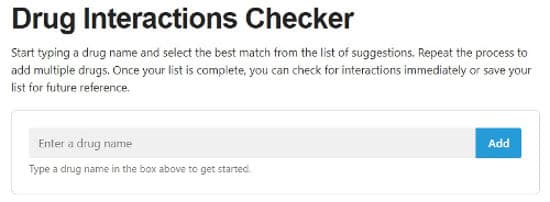
Seniors are at greater risk for harmful drug interactions
Medications, food, vitamins, and supplements all have the potential to interact with each other.
These drug interactions can cause negative side effects, unexpected symptoms, reduced medication effectiveness, or serious harm to health.
And studies show that 87% of American seniors take one prescription drug, 36% take 5 or more, and 38% use over-the-counter medications.
Even though the majority of American seniors are taking multiple medications, doctors can sometimes miss harmful drug interactions if they don't regularly review your older adult's complete list of medicine, supplements, and certain foods.
And even if a drug interaction isn’t fatal, it can affect how well the medication will work or the likelihood of side effects.
That's why it's wise to double-check on your own or ask your older adult’s pharmacist for help.
To check on your own, we found a helpful online drug interaction checker tool at Drugs.com.
It’s free, simple to use, and makes it easy to check your older adult’s complete list of medicine, supplements, and key foods.
We explain how to use this drug interaction checker tool, how to discuss potential interactions with the doctor, and why it’s important to double-check new medications that are given during a hospital stay.
How to use the Drugs.com drug interaction checker
We like using the Drugs.com drug interaction checker because it’s free, trustworthy, and easy to use.
To check 3 or fewer drugs, no sign up is needed. To check 4 or more drugs, you’ll need to sign in or create a free account.
We think this tool is worth the extra step of creating an account because this drug interaction checker gives more comprehensive reports than others.
This online tool clearly alerts you to drug interactions in your older adult’s medication list and explains how dangerous they are – from minor to serious.
Vitamins, supplements, and common foods with known interactions (like grapefruit) are also included.
This tool also alerts you to potential therapeutic duplication, meaning two medications are in the same drug category – other tools typically don’t include this feature.
For example, therapeutic duplication could happen if your older adult takes a medication that contains acetaminophen, like Norco, but also takes Tylenol for another reason. Added together, they might exceed the daily dosage limit on acetaminophen, which could be dangerous.
In this situation, it would be important to discuss this with the doctor ASAP to find out if these medications and specific doses are intentional or if it could be a mistake.
Real life drug interaction checker example
As an example, we used a list of medications commonly used by older adults to check for possible interactions.
The results shown in the report warn us about these combinations (see images below):
- Lisinopril and hydrocodone could cause dizziness
- Taking multivitamins with warfarin could be problematic
- There might be a minor issue with warfarin and the acetaminophen in Norco
- Norco and alcohol could be a dangerous combination
- Eating grapefruit and taking Norco at the same time could increase blood levels of the drug
- Warfarin has several interactions with specific foods and food groups
IMPORTANT: Never stop, start, or make any changes to medications without a doctor’s authorization. Using a drug interaction checker tool isn’t a substitute for discussing your older adult’s medications with their doctor. For questions or concerns about medications, vitamins, or supplements, always consult a doctor, nurse, or qualified medical professional before making any changes.

Enter medications, one at a time, to build a list (from Drugs.com tool)

Sample list of medications and their drug and food interactions (from Drugs.com tool)
Discuss all medications with doctors
When your older adult visits their doctor, ask them to review your older adult's complete list of medications, vitamins, and supplements.
This is especially important if they see multiple doctors – each doctor is often unaware of what others have prescribed.
As a starting point, it’s helpful to print out the drug interaction checker’s report and show it to your older adult’s doctor and ask how to make their medication regimen safer.
The notes and information in the report help you ask specifically if changes in medications are needed, why they’ve made certain medication choices, and how to reduce the risk of potential side effects.
The doctor should also be able to recommend timing for certain drugs or foods that need to be taken hours apart for safety or effectiveness or warn against certain foods.
Check drug interactions to avoid mistakes in the hospital
If your older adult is in the hospital or other health facility, medical staff will probably give them new medications on top of existing ones.
Unfortunately, mistakes can happen easily because hospitals are busy places with constant changes in nursing staff and aides who directly care for your older adult.
To avoid problems, get a list of new and existing medications so you can double-check everything using the drug interactions checker.
The last thing your older adult needs while they’re in the hospital is additional health issues caused by a preventable medication error.
Recommended for you:
- 10 Tips for Safe Medication Management for Seniors
- The Beers List: Medications Seniors Should Use with Caution
- 10 Medications That Cause Falls in Seniors: Use with Caution
By DailyCaring Editorial Team
This article wasn’t sponsored and doesn’t contain affiliate links. For more information, see How We Make Money.
[optin-monster slug=”yxbytm35zhsdfopnw7qk”][optin-monster slug=”jvhyplxmb4umsjazxecn”]
About the Author

Connie Chow
Connie was a hands-on caregiver for her grandmother for 20 years. (Grandma made it to 101 years old!) She knows how challenging, overwhelming, and all-consuming caring for an older adult can be. She also knows how important support is — especially in the form of practical solutions, valuable resources, and self-care tips.




